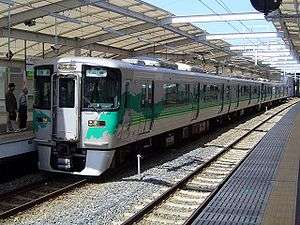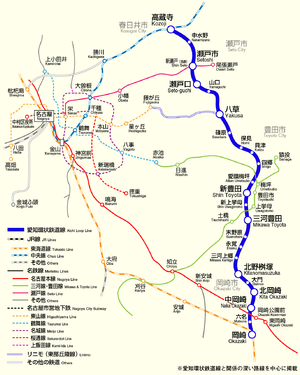Aichi Loop Line
The Aichi Loop Line (愛知環状鉄道線, Aichi Kanjō Tetsudō-sen, "Aichi Loop Railway Line") is a Japanese railway line connecting Okazaki Station in Okazaki and Kōzōji Station in Kasugai, operated by the Aichi Loop Railway (愛知環状鉄道, Aichi Kanjō Tetsudō). The company or the line is abbreviated as Aikan (愛環). This is the only line the company operates. Despite its name, the line is not a true loop, but a north-south line situated east of Nagoya, which can be considered as an unclosed loop.
| Aichi Loop Line | |||
|---|---|---|---|
 Local train at Yakusa Station | |||
| Overview | |||
| Type | Commuter rail | ||
| Locale | Aichi Prefecture | ||
| Termini | Okazaki Kōzōji | ||
| Stations | 23 | ||
| Operation | |||
| Opened | 31 January 1988 | ||
| Operator(s) | Aichi Loop Railway | ||
| Rolling stock | Aichi Loop Railway 2000 series | ||
| Technical | |||
| Line length | 45.3 km (28.1 mi) | ||
| Track gauge | 1,067 mm (3 ft 6 in) | ||
| Electrification | 1,500 V DC | ||
| Operating speed | 110 km/h (70 mph) | ||
| |||
The Aichi Loop Railway is a third sector company, with shares held by public sector such as Aichi Prefecture, the city of Toyota, and also by private companies. Unlike typical third-sector lines in Japan, the Aichi Loop Line makes a profit, since the line functions as a commuter rail line for nearby Toyota Motor factories.
Basic data
- Operators, distances:
- Aichi Loop Railway (Category 1)
- Okazaki - Kōzōji: 45.3 km (ca. 28.1 mi.)
- Japan Freight Railway Company (Category 2)
- Okazaki — Kita-Okazaki: 5.3 km (ca. 3.3 mi.)
- Freight operation ceased in 1999.
- Aichi Loop Railway (Category 1)
- Track:
- Double: Naka-Okazaki - Kita-Okazaki, Kitano-Masuzuka - Mikawa-Kamigō, Mikawa-Toyota - Shin-Toyota, Setoshi - Kōzōji
- Single: the rest
- Railway signalling: Automatic (ATS-ST)
Services
There are no rapid services. All trains stop at every station. Three or four trains run per hour.
Station list
- All stations are located in Aichi Prefecture.
- Trains can pass each other at stations marked "◇", "^", and "v".
| Station No. |
Station | Japanese | Distance (km) | Transfers | Location | ||
|---|---|---|---|---|---|---|---|
| Between stations |
Total | ||||||
| 01 | Okazaki | 岡崎 | - | 0.0 | Tōkaidō Main Line | | | Okazaki |
| 02 | Mutsuna | 六名 | 1.7 | 1.7 | ◇ | ||
| 03 | Naka-Okazaki | 中岡崎 | 1.7 | 3.4 | Meitetsu Nagoya Line (Okazaki-Kōen-Mae) | ^ | |
| 04 | Kita-Okazaki | 北岡崎 | 1.9 | 5.3 | v | ||
| 05 | Daimon | 大門 | 1.2 | 6.5 | | | ||
| 06 | Kitano-Masuzuka | 北野桝塚 | 2.2 | 8.7 | ^ | ||
| 07 | Mikawa-Kamigō | 三河上郷 | 2.0 | 10.7 | v | Toyota | |
| 08 | Ekaku | 永覚 | 1.7 | 12.4 | | | ||
| 09 | Suenohara | 末野原 | 1.6 | 14.0 | ◇ | ||
| 10 | Mikawa-Toyota | 三河豊田 | 1.9 | 15.9 | ^ | ||
| 11 | Shin-Uwagoromo | 新上挙母 | 1.7 | 17.6 | Meitetsu Mikawa Line (Uwagoromo) | ∥ | |
| 12 | Shin-Toyota | 新豊田 | 1.9 | 19.5 | Meitetsu Mikawa Line (Toyotashi) | v | |
| 13 | Aikan-Umetsubo | 愛環梅坪 | 2.0 | 21.5 | | | ||
| 14 | Shigō | 四郷 | 2.0 | 23.5 | ◇ | ||
| 15 | Kaizu | 貝津 | 2.0 | 25.5 | | | ||
| 16 | Homi | 保見 | 1.3 | 26.8 | ◇ | ||
| 17 | Sasabara | 篠原 | 2.4 | 29.2 | ◇ | ||
| 18 | Yakusa | 八草 | 2.8 | 32.0 | Linimo (L09) | ◇ | |
| 19 | Yamaguchi | 山口 | 2.6 | 34.6 | ◇ | Seto | |
| 20 | Setoguchi | 瀬戸口 | 2.1 | 36.7 | ◇ | ||
| 21 | Setoshi | 瀬戸市 | 2.4 | 39.1 | Meitetsu Seto Line (Shin-Seto) | ^ | |
| 22 | Nakamizuno | 中水野 | 2.8 | 41.9 | ∥ | ||
| 23 | Kōzōji | 高蔵寺 | 3.4 | 45.3 | Chūō Main Line[* 1] | ∥ | Kasugai |
- (some trains through to/from Nagoya)
Rolling stock
Services are operated by a fleet of 2-car 2000 series EMUs.[1]
History
The first section of the line between Okazaki and Kitano-Masuzuka opened in 1970 as the Okata Line (岡多線), a freight rail line of Japanese National Railways (JNR). The section between Kitano-Masuzuka and Shin-Toyota was extended and the whole line started a passenger service in 1976.
Another part of the line, between Setoshi and Kōzōji, was originally planned as the JNR Seto Line, a (later cancelled) freight line. The Okata Line, merged with the planned Seto Line route and the link between two, was renamed the Aichi Loop Line in 1988.
The newly founded Aichi Loop Line Company took over the line from Central Japan Railway Company (JR Central), with services starting on 31 January 1988.[2]
From 1 October 2005, through services began over the JR Chuo Main Line to Nagoya Station.[2]
See also
- List of railway lines in Japan
- Tokai Transport Service Johoku Line
- Musashino Line, semi-closed outer loop around Tokyo
- Osaka Higashi Line, Osaka counterpart
References
- 私鉄車両編成表 2012 [Private Railway Rolling Stock Formations - 2012]. Japan: JRR. July 2012. p. 97. ISBN 978-4-330-29911-2.
- Terada, Hirokazu (19 January 2013). データブック日本の私鉄 [Databook: Japan's Private Railways]. Japan: Neko Publishing. p. 110. ISBN 978-4-7770-1336-4.
External links
| Wikimedia Commons has media related to Aichi Loop Line. |
- Official website (in Japanese)
